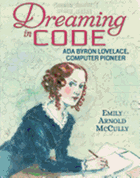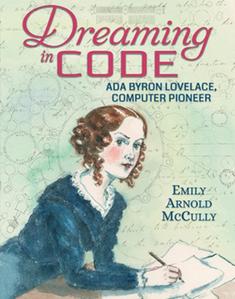
 Two centuries before computers became ubiquitous, a brilliant young British woman named Ada Lovelace imagined an "engine" that could process information much like today's computers do. The life of this forward-thinking scientist is brought to light for young readers in Emily Arnold McCully's fascinating biography, Dreaming in Code: Ada Byron Lovelace, Computer Pioneer.
Two centuries before computers became ubiquitous, a brilliant young British woman named Ada Lovelace imagined an "engine" that could process information much like today's computers do. The life of this forward-thinking scientist is brought to light for young readers in Emily Arnold McCully's fascinating biography, Dreaming in Code: Ada Byron Lovelace, Computer Pioneer.
Dreaming in Code progresses chronologically from Lovelace's birth in late 1815 (to a domineering mother and poet Lord Byron, the "titled, handsome, reckless, and irresistible" father whom she never knew) to her painful death from cancer in 1852. One of the most intriguing aspects of Lovelace's short life is the unusual way in which she was brought up. Although her controlling mother stinted on emotional nurturing, she did give Lovelace a far more rigorous education than most girls of her time were allowed. And "[d]espite the lack of affection or encouragement, Ada's intelligent, vivacious, curious, eager, and exploring nature was unimpaired." Lovelace, McCully writes, "had caught the spirit of the age, which was daring, inventive, and dazzled by the potential of technology."
As a young adult, Lovelace cultivated mentors. One of these scholarly relationships was with Charles Babbage, a quirky inventor, scientist and mathematician whom she met when she was 17 and he was 41. During their two-decades-long collaborative friendship, Babbage was developing and modifying engines designed to replace mental labor. Lovelace understood the workings of these machines in a way no one else did, even Babbage himself. In a "great leap of imagination," she grasped something fantastic about Babbage's "Analytical Engine": "Many persons," she wrote, "imagine that because the business of the engine is to give its results in numerical notation, the nature of its processes must consequently be arithmetical and numerical, rather than algebraical and analytical. This is an error. The engine can arrange and combine its numerical quantities exactly as if they were letters or any other general symbols." This concept, more than the invention itself, is what makes Babbage's engine a proto-computer, and what makes Lovelace a pioneer in the information age.
McCully is the Caldecott Medal-winning author/illustrator of Mirette on the High Wire as well as dozens of other children's books, including She Did It!: 21 Women Who Changed the Way We Think and Clara. Dreaming in Code is written with grace and intelligence, researched with care and peppered with historic photos and remarkable illustrations of 19th-century technology. It's sure to inspire a new generation of pioneers unwilling to let obstacles distract them from leading the way into the future. --Emilie Coulter, freelance writer and editor
Shelf Talker: Emily Arnold McCully's hugely enjoyable biography of Ada Byron Lovelace reveals how she overcame 19th-century societal norms and a highly dysfunctional family to set the information age in motion.

